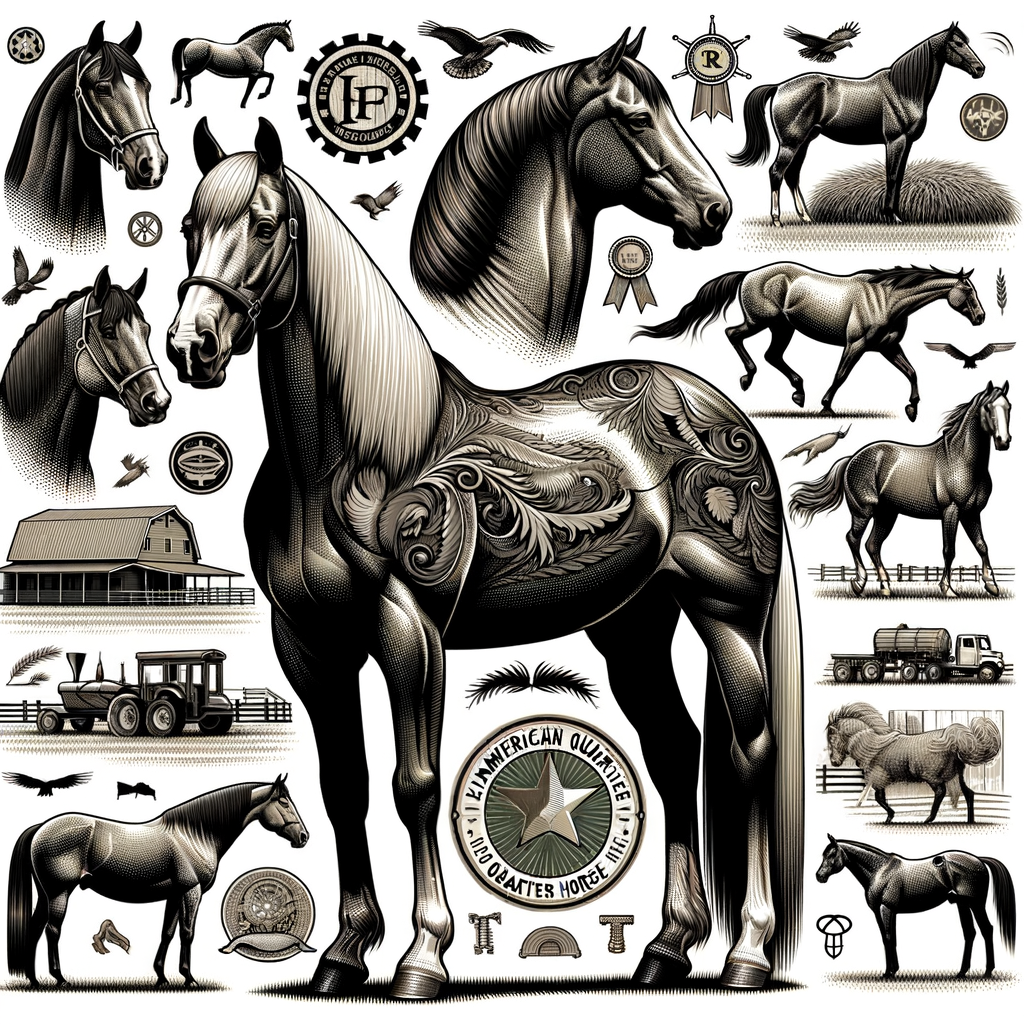
Introduction to Quarter Horse History
The Quarter Horse, a breed that has become synonymous with American history, has a rich and fascinating past. This breed has not only played a significant role in shaping the American West but also holds a special place in the hearts of horse lovers worldwide. Let’s delve into the origins of this remarkable breed, its significance in American history, and its role in shaping the American West.
- Origins of the Quarter Horse Breed
- Significance in American History
- Role in Shaping the American West
The Quarter Horse breed traces its roots back to the 1600s. English colonists in Virginia crossed imported Thoroughbreds with native horses, resulting in a breed known for its speed, strength, and endurance. The name ‘Quarter Horse’ comes from the breed’s ability to outpace other horse breeds in races of a quarter mile or less. These horses were not just fast; they were also known for their calm demeanor and intelligence.
The Quarter Horse has played a pivotal role in American history. These horses were the preferred mounts of the American cowboys in the 19th century. Their speed and agility made them perfect for cattle herding and other ranch work. The Quarter Horse was also the horse of choice for pioneers heading west during the American Frontier period, contributing significantly to the westward expansion of the United States.
The Quarter Horse’s role in shaping the American West is undeniable. These horses were integral to the development of the West, helping settlers establish ranches, farms, and towns. Their strength and endurance made them ideal for the hard work required in these new territories. The Quarter Horse also played a significant role in transportation, carrying mail and passengers across the vast expanses of the American West.
In conclusion, the Quarter Horse breed has a rich history that is deeply intertwined with the history of America. From its origins in colonial Virginia to its significant role in the American West, the Quarter Horse has left an indelible mark on the American landscape and continues to be a beloved breed today.
Heritage of Quarter Horses
The Quarter Horse, a breed known for its speed and versatility, has a rich and diverse heritage. Its ancestry can be traced back to the early Spanish and English horses, each contributing unique traits that have shaped the Quarter Horse we know today.
Early Ancestry of Quarter Horses
The early ancestry of Quarter Horses is a fascinating tale of two worlds colliding. Let’s delve into the importance of Spanish and English horses in the lineage of this remarkable breed.
- Importance of Spanish horses in Quarter Horse lineage
- English horses and their influence
The Spanish horses, brought to the Americas by explorers in the 16th century, played a pivotal role in the Quarter Horse lineage. Known for their endurance, agility, and adaptability, these horses were perfect for the rugged terrains of the New World. They quickly became an integral part of the Native American culture, used for hunting, warfare, and transportation. The influence of these Spanish horses is still evident in the Quarter Horse’s stamina, quick reflexes, and versatility.
The English horses, introduced to America in the 17th century, brought a new dimension to the Quarter Horse lineage. Renowned for their speed and power, these horses were primarily used for racing and pulling carriages. The Thoroughbred, a breed of English horse, was particularly influential. Its speed and strength were highly desirable traits that were bred into the developing Quarter Horse breed. This is why today’s Quarter Horses are known for their incredible sprinting ability, often outpacing other breeds in short distance races.
In conclusion, the Quarter Horse owes its unique characteristics and abilities to its Spanish and English ancestors. The blend of endurance, agility, speed, and power makes this breed one of the most versatile and popular in the world.
American Quarter Horse Heritage
The American Quarter Horse has a rich and fascinating heritage. It is a breed that has been developed and shaped by the needs and desires of the American people. Let’s explore the development of this breed in America and its role in farming, racing, and warfare.
- Development of the Breed in America
The American Quarter Horse breed was developed in the 17th century in the United States. The breed was initially a mix of English Thoroughbreds and native horses of Spanish origin. The goal was to create a horse that was fast, sturdy, and versatile. The breed was named “Quarter Horse” because of its exceptional speed in quarter-mile races.
Over time, the breed was refined to excel in various roles, from working on farms and ranches to racing and warfare. The American Quarter Horse Association (AQHA) was established in 1940 to preserve, improve, and record the pedigrees of the American Quarter Horse.
- Role in Farming, Racing, and Warfare
The American Quarter Horse has played a significant role in American history. In farming, these horses were indispensable. They were used for plowing fields, herding cattle, and pulling wagons. Their strength and endurance made them ideal for these tasks.
In the world of racing, the American Quarter Horse is renowned for its speed and agility. They are particularly known for their performance in quarter-mile races, where they can reach speeds of up to 55 mph.
The American Quarter Horse also served in warfare. During the American Revolution and the Civil War, these horses were used for transportation and in combat. Their speed, strength, and courage made them invaluable assets on the battlefield.
| Role | Contribution |
|---|---|
| Farming | Used for plowing fields, herding cattle, and pulling wagons |
| Racing | Known for their speed in quarter-mile races |
| Warfare | Used for transportation and in combat during the American Revolution and the Civil War |
In conclusion, the American Quarter Horse has a rich heritage that is deeply intertwined with American history. From its development to its various roles, this breed has proven to be versatile, resilient, and truly American.
Famous Quarter Horses and their Contributions
Quarter Horses have a rich history, with many famous horses making significant contributions to the breed. Let’s take a closer look at some of the most notable Quarter Horses and their contributions.
Notable Quarter Horses
- Steel Dust: The foundation sire
- Peter McCue: The influential stallion
- Wimpy: The first AQHA Champion
Steel Dust, born in 1843, is often referred to as the foundation sire of the Quarter Horse breed. His speed and strength were legendary, and his offspring inherited these traits, helping to establish the Quarter Horse as a distinct breed.
Peter McCue, born in 1895, was another influential Quarter Horse. Known for his impressive size and speed, he sired many successful racehorses. His genes continue to influence the breed today, with many modern Quarter Horses tracing their lineage back to him.
Wimpy holds a special place in Quarter Horse history as the first horse registered by the American Quarter Horse Association (AQHA). Born in 1936, Wimpy was known for his calm temperament and versatility, traits that have become hallmarks of the breed. He was named the first AQHA Champion in 1941, cementing his place in history.
These notable Quarter Horses have each played a significant role in shaping the breed we know and love today. Their contributions, from establishing the breed to influencing its traits, are a testament to the enduring legacy of the Quarter Horse.
Influential Quarter Horses in Popular Culture
Quarter horses have not only made a significant impact in the world of horse racing and breeding, but they have also left their mark in popular culture. Let’s take a closer look at two influential quarter horses that have gained fame and recognition beyond the racetrack.
- Trigger: The golden palomino of Roy Rogers
- Scamper: The champion barrel racer
Trigger, a beautiful golden palomino, was the beloved horse of the famous cowboy actor, Roy Rogers. Trigger was known for his intelligence, speed, and ability to perform tricks, which made him a star in his own right. He appeared in over 80 films and numerous television shows, capturing the hearts of audiences worldwide. Trigger’s popularity helped to highlight the versatility and charisma of the quarter horse breed.
Scamper, a quarter horse gelding, is one of the most successful barrel racing horses in history. With his rider, Charmayne James, Scamper won an unprecedented 10 World Champion titles at the National Finals Rodeo. His agility, speed, and determination made him a legend in the sport. Scamper’s success story showcases the athletic prowess and competitive spirit of quarter horses.
These two horses, Trigger and Scamper, have not only contributed to the popularity of the quarter horse breed but have also become cultural icons. Their stories continue to inspire horse lovers and enthusiasts around the world.
Quarter Horse Breeds: A Closer Look
Let’s delve deeper into the fascinating world of Quarter Horse breeds. We’ll start by examining the key characteristics that define this breed, including their physical attributes and temperament.
Characteristics of the Quarter Horse Breed
Quarter Horses are distinct and easily recognizable due to a combination of their physical attributes and unique temperament. Let’s explore these characteristics in more detail.
- Physical attributes
- Temperament and behavior
Quarter Horses are known for their muscular build, compact body, and broad chest. They typically stand between 14 and 16 hands high (a hand is a unit of measurement equal to 4 inches), making them a medium-sized horse breed. Their heads are finely chiseled with a straight profile, and they have wide-set, alert eyes. The coat of a Quarter Horse can be any color, with the most common being sorrel, a reddish-brown.
Quarter Horses are renowned for their calm and steady temperament. They are intelligent, quick learners, making them ideal for a variety of equestrian activities. They are also known for their agility and speed, particularly over short distances, hence their name. This breed is often described as having a ‘cow sense’, an instinctive understanding of how to work with cattle, which makes them excellent ranch horses.
Understanding the Quarter Horse’s characteristics helps us appreciate why this breed is so beloved and versatile. Whether for work or pleasure, the Quarter Horse’s physical attributes and temperament make it a favorite choice among horse enthusiasts.
Variations within the Quarter Horse Breed
Within the Quarter Horse breed, there are several variations that have been developed to excel in different areas. Let’s take a closer look at two of these variations: Performance Quarter Horses and Halter Quarter Horses.
- Performance Quarter Horses
- Halter Quarter Horses
Performance Quarter Horses are known for their agility, speed, and versatility. They are bred and trained for a variety of activities such as racing, rodeo events, and working cattle. These horses are often characterized by their muscular build, quick reflexes, and strong work ethic.
One famous example of a Performance Quarter Horse is “Doc Bar”, a legendary horse who made a significant impact on the breed. Despite his initial failure as a racehorse, he became an outstanding sire, producing offspring that excelled in cutting and other performance events.
Halter Quarter Horses, on the other hand, are bred and trained for halter classes, a type of horse show class where horses are judged based on their conformation, or physical appearance, rather than their performance. They are typically larger and more muscular than Performance Quarter Horses.
“Impressive”, a Halter Quarter Horse, is well-known in the horse community. Despite his controversial legacy due to a genetic disease, he is remembered for his exceptional conformation and has left a lasting influence on the Halter Quarter Horse breed.
Both Performance and Halter Quarter Horses have their unique strengths and contributions to the Quarter Horse breed. Whether it’s the agility and versatility of Performance Quarter Horses or the impressive conformation of Halter Quarter Horses, each variation brings something special to the table.
Preserving the Quarter Horse Legacy
The Quarter Horse is a breed with a rich history and a strong legacy. It’s our responsibility to preserve this legacy for future generations. A key player in this preservation effort is the American Quarter Horse Association (AQHA).
The Role of the American Quarter Horse Association (AQHA)
The AQHA plays a crucial role in maintaining the integrity of the Quarter Horse breed and promoting its heritage. Let’s take a closer look at some of the ways they do this.
- Registration and breed standards
- Promotion of the breed and its heritage
The AQHA is responsible for registering Quarter Horses and setting the breed standards. This ensures that only horses that meet these strict standards are recognized as true Quarter Horses. The AQHA’s registration process involves detailed documentation, including the horse’s lineage and physical characteristics. This rigorous process helps to maintain the breed’s purity and quality.
Another significant role of the AQHA is promoting the Quarter Horse breed and its heritage. They do this through various initiatives, such as educational programs, events, and publications. These efforts help to raise awareness about the breed’s unique qualities and historical significance. The AQHA also recognizes and honors outstanding Quarter Horses and individuals who have contributed to the breed’s legacy.
In conclusion, the AQHA plays an indispensable role in preserving the Quarter Horse legacy. Through their rigorous registration process and breed standards, they ensure the breed’s quality and purity. Through their promotional efforts, they raise awareness about the breed and its heritage. As we look to the future, it’s clear that the AQHA will continue to be a vital player in preserving the Quarter Horse legacy.
Future of the Quarter Horse Breed
The Quarter Horse, known for its agility and speed, has a bright future ahead. Let’s take a closer look at what’s in store for this remarkable breed.
- Continued Popularity in Equestrian Sports
- Conservation Efforts for the Breed
The Quarter Horse continues to dominate the equestrian sports scene. Its unique combination of speed, strength, and agility makes it a favorite among riders and spectators alike. In fact, according to the American Quarter Horse Association, there are over 3 million registered Quarter Horses worldwide, a testament to their enduring popularity.
These horses excel in a variety of disciplines, from barrel racing to reining, and their versatility ensures they will remain a staple in equestrian sports. As younger generations discover the thrill of these sports, the demand for Quarter Horses is expected to remain strong.
Preserving the Quarter Horse breed is of utmost importance. Conservation efforts are underway to ensure the breed’s longevity and maintain its unique characteristics. The American Quarter Horse Association plays a pivotal role in these efforts, setting strict breed standards and overseeing the registration of new horses.
Moreover, conservation programs are working to protect the genetic diversity of the breed. These initiatives aim to prevent inbreeding and ensure the health and vitality of future generations of Quarter Horses. Through these efforts, the Quarter Horse breed is poised to thrive in the years to come.
| Key Facts About the Quarter Horse |
|---|
| Number of Registered Quarter Horses Worldwide: Over 3 million |
| Popular Disciplines: Barrel Racing, Reining, Roping |
| Key Conservation Efforts: Breed Standards, Registration Oversight, Genetic Diversity Programs |









